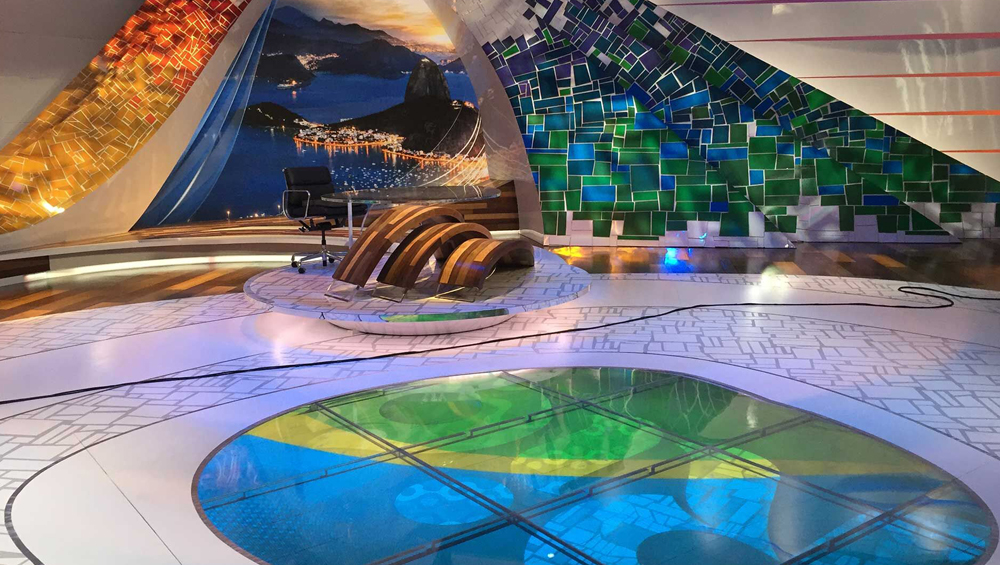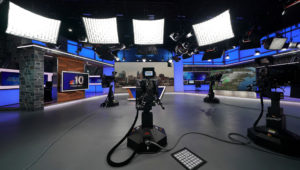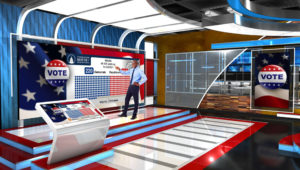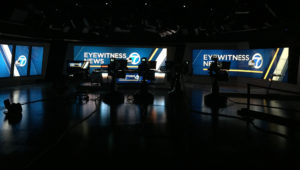
Video Walls Advance Set Design, Storytelling

On baseball’s opening day this year, former Phillies star Jimmy Rollins stood in a batter’s box on the studio floor of NBCU-owned WCAU Philadelphia, demonstrating the swing of current slugger Bryce Harper.
To get the effect, WCAU hadn’t trucked in the dirt and home plate. Rather, it used the latest LED video technology for the demonstration, courtesy of vendor-partner Leyard.
Broadcasters are using such LED video displays to bring new experiences to viewers. The technology serves as a “stepping stone” to more advanced storytelling, and broadcasters are increasingly including large video walls in their new set designs.
New light emitting diodes (LED) walls have recently debuted at NBCU’s WCAU (NBC10) and its Telemundo62 (WWSI) in Philadelphia, on Fox Sports for the men’s World Cup in Russia, and the coming Black News Channel sets will feature large LED walls as well.
Current LED video walls permit greater set and graphical flexibility while delivering crisper images compared to the liquid crystal display (LCD) panels and LED walls of the past, often at lower cost than the previous technology.
Achieving stunning visuals on an LED wall requires more than just a quality installation. LED technology has evolved, alongside improvements in graphics, controllers and other pieces of technology needed to bring these new visual elements to life. Competition and technology improvements have also brought prices within the budgetary reach of smaller stations. At the same time, caveat emptor remains a must in the LED market, according to one vendor.
WCAU, which began broadcasting from a new IP-based studio last October, anchors its set with a 20-foot wide by 10-foot tall 4K resolution LED wall that the station uses for all of its newscasts.

WCAU Philadelphia anchors its new set with a 20-foot wide by 10-foot tall 4K resolution LED wall. The set also feature a smaller 11 foot by 6 foot high-resolution LED display and a smaller custom LED display on the news desk. (Joe Kaczmarek for NBC10/Telemundo62)
“It commands attention when you walk into the studio,” says Tony Plosz, VP of operations and engineering for WCAU and WWSI.
NBC10 also features a smaller 11 foot by 6 foot high-definition resolution LED wall for weather along with a smaller custom LED display on the news desk itself, and Telemundo62 is based on the same concept.
“We’re still coming up with ideas for different animated backdrops,” Plosz says about the wall, which gives “flexibility and creative freedom” to the station’s journalists for creatively telling stories. “This is a stepping stone to more advanced storytelling.”
The 16×9 LED panel being is allowing the station to “ditch the green screen” for weather and other presentations, Plosz says. Having a monitor source behind the talent that displays sharp images gives them the ability to actually see what they’re pointing at. “It looks great on television, and it helps the talent as well.”
Part of the draw of video walls for broadcasters is the shift from static to dynamic content, says Kathy Skinski, GM for broadcast and media at Leyard, which specializes in LED displays. Broadcasters can “change it for a story, do branding, a sponsorship activity. It changes the whole game in terms of what they can do from storytelling to replays.”
Matrox Director of Sales Samuel Recine says “a video wall is a very personal project.” While there are commonalities in the industry, he says, the presentation of content will be unique from one to the next, as each is called on to fulfill a different set of priorities. “From one project site to another, the priorities can be vastly different. Who can access it? Who has permission to change it? Is it there for decoration or wow factor? It varies from video wall to video wall.”
Diane “DiFi” Fiolek, creative services director at Devlin Design Group, says, “everybody wants a video wall, and they want a big video wall,” often one larger than the budget allows.
Size aside, the important thing is that the video wall actually meets the broadcaster’s needs, she says.
Devlin has designed the new Black News Channel sets, which will feature two “of the biggest, largest LED screens in the country. Those will be giant performance areas for them,” Fiolek says.

Devlin Design Group designed the Black News Channel studios, which feature LED video walls. (Source: Devlin Design Group)
LED isn’t just for vertical presentations. Leyard worked with partners at NBC in Philadelphia to present a 15×8 LED floor for the opening day of Major League Baseball. That, in turn, enabled Phillies vet Rollins to stand over the display-turned-batter’s-box and demonstrate Harper’s swing. Such a use of the tech can “bring the whole game experience to the viewer,” Skinski says.
The LED floors are durable, she adds. “You can step on it. We can roll trucks over it. It’s great for sports,” Skinski says.
Moving into the future, Mack McLaughlin, CEO of FX Design, believes the entire background of sets will shift to video, resulting in the need for “less built scenery.”
While video walls grant flexibility for changing a set’s look on the fly, those looks must still be designed. “For scenic elements in video and virtual, it takes more time to design them to look real than when we design for a built product,” McLaughlin says.
Evolving Technology
LCD displays have “obvious flaws,” chief among them the seams between display sections, notes Charles Markovits, national sales manager for broadcast at Neoti. An additional flaw, he says, is the fact that lighting grids will create reflections on the glossy coating on LCD displays.
A properly installed LED will not have evident gaps or seams, and by its nature will not reflect objects in front of it. LEDs also provide wider viewing angles, which make it possible to establish more creative shots, such as higher angles.
A well-designed LED video wall system delivers a quality image, and a lot goes on behind the scenes to make that possible, says Ted Romanowitz, senior product manager of LED at Christie. Color space, refresh rate and bit depth all come into play, and LED video walls also require a solid backend system and compatibility with existing studio equipment.
“It’s the little geeky things we talk about as engineers, as product people, that go the extra mile to make it look really, really good,” Romanowitz says.
One “geeky thing” for LED walls is pixel pitch, and the tighter it is, the closer the talent and camera can be to the wall. For years, the pixel pitch hovered around five millimeters, but companies have introduced technologies that lower that significantly.
“Right now, the sweet spot is 2.5 millimeters and the talent 6 to 8 feet away, where we want them anyway, and the desk 10 to 12 feet away,” says McLaughlin of FX Design. “That seems to be what everyone’s going for at the local level and a price point that they can afford.”
There are a number of LED technologies on the market at different price points, such as crystal, mini, microtile and regular.
Kevin O’Connor, sales and marketing director for Visual Simulation and Entertainment Solutions at Sony Electronics, says the LEDs used in the company’s crystal LED walls are 100 times smaller than traditional LED and 50 times smaller than the closest competitor. The advantage of minute light elements is that 99.9% of the wall surface is black, which makes it possible for the wall to deliver a contrast ratio of more than 1 million to 1, he says.
Fox Sports used a crystal LED wall on set with commentators for the Men’s World Cup in Russia. Three of the four sides of the studio had windows, so the wall had to function in high brightness with the sun shining in. “It more than held up in what would be considered very extreme lighting conditions,” O’Connor says.
But the quality comes with a price.
“This is not your dad’s Oldsmobile. It’s a Lamborghini,” O’Connor says. But that Lamborghini’s price can be hard to pin down. A Sony spokesperson says: “It’s hard for us to ballpark pricing on a premium solution such as this, since it varies so greatly based on a number of factors including the desired size, resolution and configuration needs.”
Other vendors are working on ways to reduce costs associated with LED video walls by improving the technology, while others are trying to reduce costs through cheaper components.
Chanan S. Averbuch, Prime View’s EVP of the Americas, says the company has developed a new way to engineer the LED wall technology to reduce the weight and thereby drop installation prices and to lower power consumption, leading to lower ongoing operations expenses and total cost of ownership. The answer is in nanotechnology, he says.

Sets can feature a mix of displays, such as this one provided by Prime View for KABC Los Angeles, which shows flanking LCD, seamless LED and nearly seamless LCD. (Source: Prime View)
“It’s cost effective, and it’s not the cheap stuff,” Averbuch says. The MSRP on Prime View’s FusionMAX line is $85,000, he says.
Another area for potential cost savings is in materials selection, he says, noting Prime View is moving from die-cast aluminum to magnesium, which is lighter.
Given the capital investment, buyers are often concerned about the projected lifespan of video walls and how long the walls will look their best.
Video walls in broadcast studios typically don’t run at full brightness, but LEDs will still degrade over time. Romanowitz notes that Christie’s microtiles monitor the quality of the image of each LED and use system intelligence to maintain a uniform color and brightness as the LEDs degrade over time.
An LED may be expected to reach half brightness in 11 years, but that’s when running 24/7 at full brightness. Broadcasters typically run LED walls at lower levels of brightness, so they can be expected to last longer.
“The wall isn’t going to die,” Sony’s O’Connor says. “A new technology will come and replace it.”
All In The Workflow
Graphics tools like ChyronHego’s Prime platform can be used to generate graphics displayed on the video walls, and templates can be created to ease the process.

Video walls are being used for a variety of programming. (Source: ChyronHego)
“Once these systems are set up, it’s a matter of workflow,” says Olivier Cohen, ChyronHego’s head of commercial strategy. “You can have objects popping out of the wall to tell stories” using virtual and augmented reality, which runs on the Unreal rendering engine.
While what the viewer sees is splashed across the video wall, “the magic of what actually appears takes place on a piece of equipment called a video wall controller,” Matrox’s Recine says.
And those video controllers, like much else in the broadcast industry, are undergoing an important transition from baseband management, which can handle HDMI or SDI, to IP.
“This has big ramifications for the video wall business,” Recine says, such as the number of possible input sources and the distance of the sources from the video wall controller.
Another part of the behind-the-scenes magic is signal monitoring to ensure what appears on the video wall is “actually correct,” Kevin Joyce, senior advisor at Tag Video Systems, says.
Multiviewers are part of workflow that is becoming increasingly efficient as broadcasters embrace the IP transition, Joyce says.
“IP workflows allow video to be used in many more applications than ever before,” Joyce says.
Caveat Emptor
Quality installation is crucial.
“A lot of the tech is the same, but the people that install and support it and the company behind it are really critical,” Plosz says. “Cameras are unforgiving. If you’re looking at a 4K image behind the anchor desk and there’s a gap that can be seen, it takes away from the experience.”
And because video walls represent a major capital investment, Romanowitz urges the buyer beware.
Prospective buyers should test the LED with their own content using their own studio, camera and lights “to make sure the technology delivers and looks good before you buy it,” Romanowitz says.
He cites a story of a vendor demonstrating one LED product for a West Coast broadcaster, but installing a different one to meet the buyer’s price requirements. “It didn’t look good. It looked horrible. They pulled it out and had it replaced by a different company,” he says.
Part of the problem, he says, has been the influx of “the many Chinese manufacturers aggressively entering international markets with very low-priced products, poor minimally acceptable quality, and lack of pro AV integration, fulfillment and support services,” he says. “I call it the Wild, Wild East.”


































Comments (0)